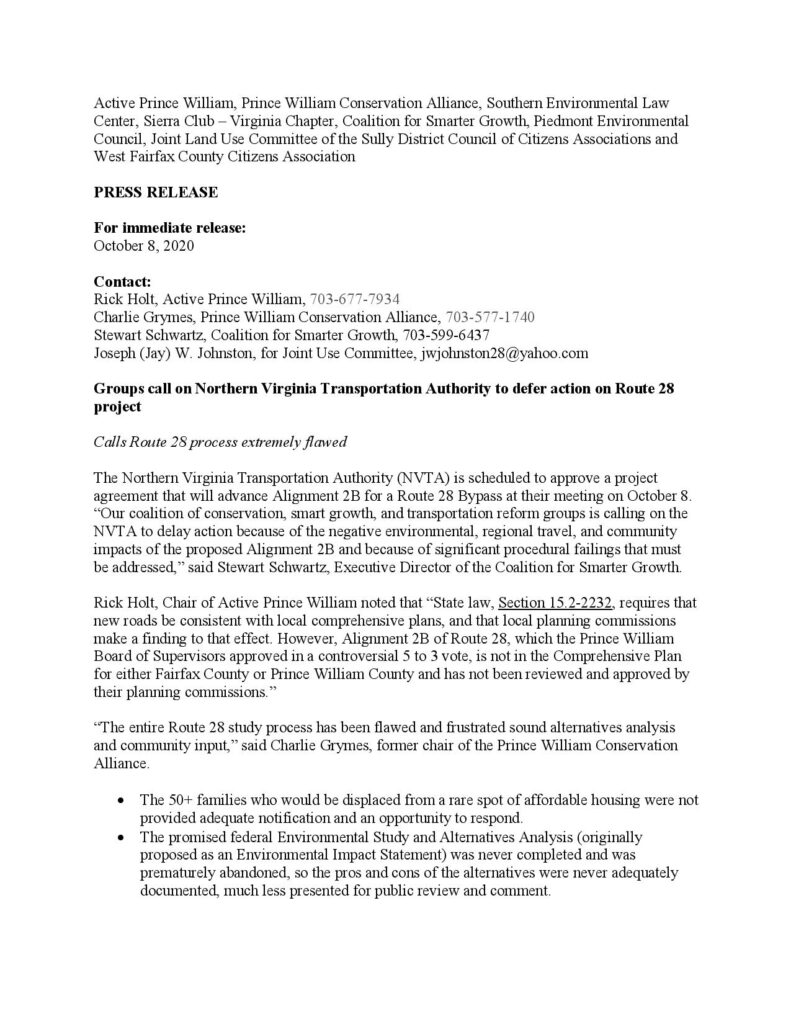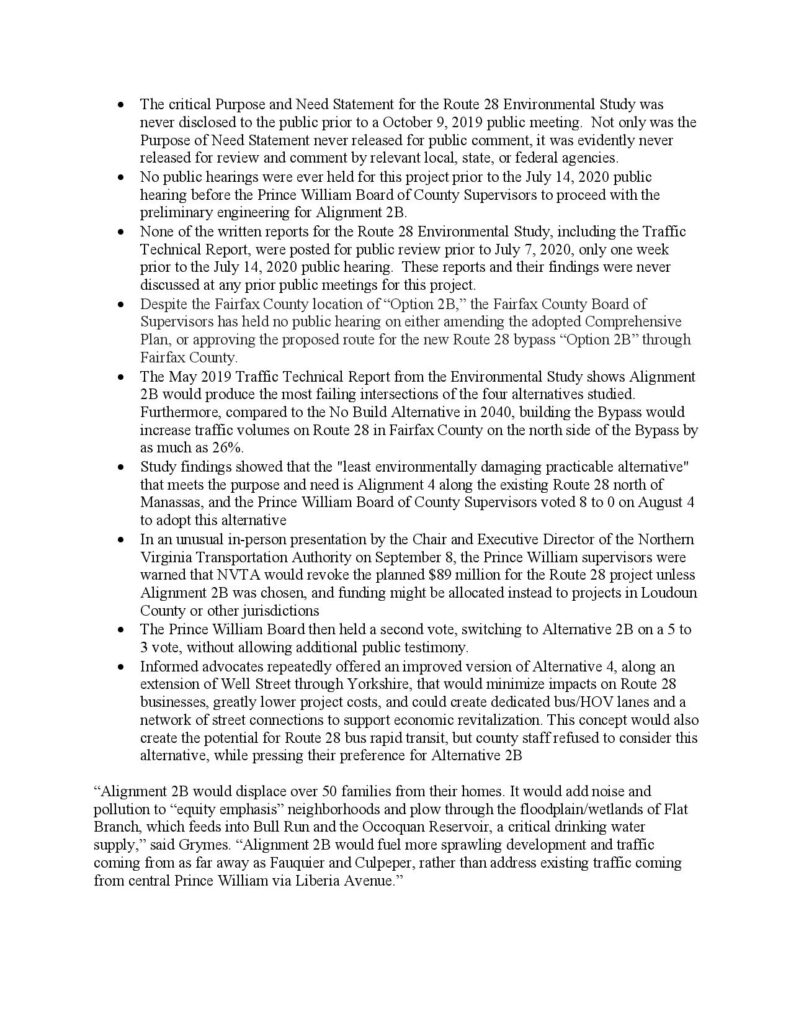Coalition for Smarter Growth
February 12, 2021
For Immediate Release
Contact: Stewart Schwartz, CSG, 703-599-6437
“Voices of the Region” Survey Shows the Region’s Residents Want to Walk and Bike More, Drive Less, and Prioritize Projects that Address Climate Change
Points to Need for Less Road Building, and More Sustainable, Walkable Communities
A recently completed survey asked the Metropolitan Washington region’s residents about their travel before, during and after the COVID-19 pandemic. The results show that residents’ travel patterns have changed as a result of the pandemic and that they would like to continue to walk and bike more and drive less post-pandemic. These results are similar to those from a national survey project.
The National Capital Region Transportation Planning Board (TPB) will receive a presentation at its meeting Wednesday, February 17, on the survey, which is intended to inform the update to the regional long-range transportation plan. This survey was conducted using randomly drawn addresses, covered all geographic sub-areas of the region and resulted in over 2,400 complete responses, with a margin of error of +/-2.5%.
“The findings of this survey are critically important and should be an important factor in the Transportation Planning Board’s development of their next long-range transportation plan, which is underway right now,” said Stewart Schwartz, Executive Director of the Coalition for Smarter Growth.
“Recently, the TPB voted to prioritize projects that reduce vehicle miles traveled and greenhouse gas emissions. This survey points to public support for telecommuting, walking, biking, and reducing greenhouse gas emissions. Climate change is a bigger concern than traffic congestion according to the survey,” said Bill Pugh, Senior Policy Fellow for CSG. “Land use must be a core solution to achieve people’s goals of driving less, walking and biking more, and fighting climate change. In fact the survey showed the benefits of this approach in that people living in DC, Arlington, and Alexandria, our most compact jurisdictions with the most transit oriented land use, expressed the least concern about traffic congestion.”
“We hope that our elected officials and government transportation planners will take to heart both the results of this survey and the urgency to reduce driving and associated greenhouse gas emissions when they create our next regional transportation plan,” said Schwartz. “In the process there will be other significant benefits including meeting people’s desire to walk and bike more, and create a world that future generations will thank us for.”
CSG’s Summary of Important Findings from the Survey
More Walking and Biking, Less Driving Anticipated for All Travel Post-Pandemic
38% of respondents expect a change in their travel patterns (both work and non-work travel) one year post-pandemic compared to their pre-pandemic travel patterns. 53% of all respondents anticipate walking more and 26% anticipate biking more, in contrast to only 3% who anticipate walking or biking less. While 34% of residents anticipate driving more, this was more than offset by the 47% of respondents who anticipate driving less for daily trips, a 13 percent net difference of residents who anticipate driving less.
Overwhelming Support for Expanded Pedestrian Zones, Bike Lanes, Bus Lanes
Three quarters of survey respondents said they supported use of street space for expanded pedestrian access and restaurant seating. 63% support more or wider sidewalks and bike lanes.
While transit ridership has been impacted by the pandemic, a clear majority of the region’s residents, 71%, which includes many non-bus riders, support dedicated bus lanes. And a narrow majority (54%) are supportive of dedicated bus lanes even in situations that involve removal of on-street parking.
Additional Bicycle Infrastructure, Road Safety Measures, or Access to a Bicycle Would Make Most of the Region’s Residents More Likely to Bike
The survey asked respondents about improvements that would make them more likely to use a bicycle. The proposed improvements with the highest percentages of residents more likely to bike as a result were: more direct and complete bicycle lanes and routes (34% of respondents), bicycle lanes separated from vehicles by a barrier (32%), and bicycle lanes or trails near home (31%). Overall, only a minority (42%) of all residents indicated that no improvements would make them more likely to use a bike.
When broken down by age, the impact of bike infrastructure improvements for the region’s residents under 30 was especially high. Almost half indicated that more direct and complete bicycle lanes and routes or lanes near home would make them more likely to bike. Only a small minority (24%) indicated that no improvements would make them more likely to use a bike.
Less Transit Use Anticipated, But Respondents Indicate Service Enhancements Would Make Them More Likely to Use Transit
While 13% anticipate using transit more, 38% anticipate using it less one year post-pandemic. Only 5% of frequent transit riders pre-pandemic and only 26% of infrequent transit riders pre pandemic indicated that nothing would make them more likely to ride public transportation after the pandemic.
Most respondents cited measures that transit agencies can undertake to make them more likely to ride transit. About half of frequent transit users pre-pandemic responded that more frequent cleaning, more spacing of people on bus and train cars, and more frequent service would make them more likely to use transit after the pandemic. (Of note, numerous studies have shown that even during the pandemic, riding transit is relatively low risk. Also, transit agencies in the region have implemented some of these safety measures already).
“The survey shows that frequency and reliability of service and convenient real-time travel information continue to be significant factors for making people more likely to use transit. Safe and convenient routes to walk, bike or scoot to train stations and bus stops were also found to be significant factors in transit ridership, where more improvement is needed across the region,” said Schwartz.
Climate Change is a Significant Concern and Residents Overwhelming Want Officials to Address it in Transportation Plans
84% of the region’s residents agree with the statement that elected officials need to consider the impacts of climate change when planning transportation in the future. For residents under 30 years of age, those most impacted by our long-range planning decisions and climate change, that percentage rises to 92%.
Traffic Congestion is Less of a Concern Than Climate Change
Less than half of respondents (44%) indicated that traffic congestion is a significant concern that impacts their lives. 25% said congestion was somewhat a concern that impacted their lives a little.
Residents of core jurisdictions (Arlington, Alexandria, and the District of Columbia) reported the highest satisfaction with the transportation system and least concern about congestion. 75% of Core residents say that the regional transportation system meets their needs very well or somewhat well, in contrast to 55% of Inner Suburb (Montgomery, Fairfax, Prince George’s) residents and 38% of Outer Suburb residents. Likewise, only 27% of Core residents say that congestion is a significant concern that impacts their quality of life, in contrast to 46% of Inner Suburb residents and 54% of Outer Suburb residents.
“What these survey results suggest is that the more compact development in the core doesn’t reduce the satisfaction of residents when it comes to transportation, and may reflect the variety of transportation options available (walk, bike, transit) and shorter commutes or trips to the corner store. In contrast, people living farther out are being provided with fewer non driving options and face longer commutes in congestion generated by high-levels of auto dependent development,” said Pugh. “It points to the need for more housing options in the region’s walkable communities near transit and job centers, along with more affordable housing in these locations, and increased investment in transit.”
Residents Say that Future Generations Will Thank Us More for Clean Transportation, Transit, Walking, and Biking than for Wider Roads
The survey asked “What transportation investments should we make today that future generations will thank us for tomorrow?” and allowed respondents to provide their own open ended answers.
The majority of the answers involved clean transportation, public transportation, and improvements for walking and biking. A much smaller group cited roads, parking, and congestion.
● 259 responses mentioned expanding areas served by rail transit and bike infrastructure
● 172 mentioned clean transportation (electric vehicles, lower emissions)
● 72 responses mentioned improving the condition of (fixing and making more resilient) existing roads and bridges.
● Just 134 responses mentioned more or wider roads
Increased Telecommuting
33% of respondents anticipate telecommuting at least one day a week after the pandemic, up from 16% who telecommuted at least one day a week pre-pandemic. Among the 60% of respondents currently telecommuting during the pandemic, approximately half would want to continue to telework 3-4 days per week.
“Both national and local surveys of employers and employees predict sustained higher rates of teleworking after the pandemic compared to beforehand. This means that many of the highway and arterial expansion projects being planned in the region are based on outdated travel forecasts. Many of these projects were based on the premise of addressing peak-of-the-peak commuting congestion, but these trips may fall significantly. The Washington, DC region needs to cancel or at least put on the back burner these major road expansion proposals,” said Schwartz. “At the same time, we need to ensure that our transit system meets the needs of people returning to work and addresses their concerns, especially people without personal vehicle options.”
Land Use and Affordable Housing are Key Solutions But Are Missing From the Survey
“The Voices of the Region survey asked some great questions and provided lots of valuable insights. However, one of the areas it missed was asking about the proximity of services and destinations that are important to residents,” said Pugh.
● Do residents live close to their basic needs and would they want to have them closer?
● What factors make that difficult, is it due to the lack of affordable housing in walkable, mixed-use neighborhoods or due to job centers in isolated office parks?
“We see that 75% of Core residents find that the region’s transportation system meets their needs, and that has as much to do with the compact, walkable built environment as with the transportation options available beyond driving in places like DC, Arlington and Alexandria,” said Pugh.
Pugh continued, “three fourths of the trips in the region are for non-commuting purposes, so even if people are teleworking more, they will still want shorter and easier trips that don’t always involve getting in the car. The best way to address the evolving travel needs and desires of most residents to walk and bike more, is in our land use planning. Mixed-use, walkable, compact neighborhoods offer safe and convenient options for accessing basic needs.”
A Gap in the Survey — Failure to Reach Enough Low-Income Residents
“Low-income residents were less well represented than other groups according to consultant staff who presented the survey results at the TPB’s recent Technical Committee meeting. So it would be good to understand from the focus groups and possible follow-up surveys how the region can best meet the transportation and housing location needs of low-income residents and workers,” said Pugh. While low-income residents expressed similar satisfaction with the transportation system as non-low-income residents, staff said in their presentation that this result may be due to the concentration of those low-income residents sampled in Core and Inner jurisdictions.
###







